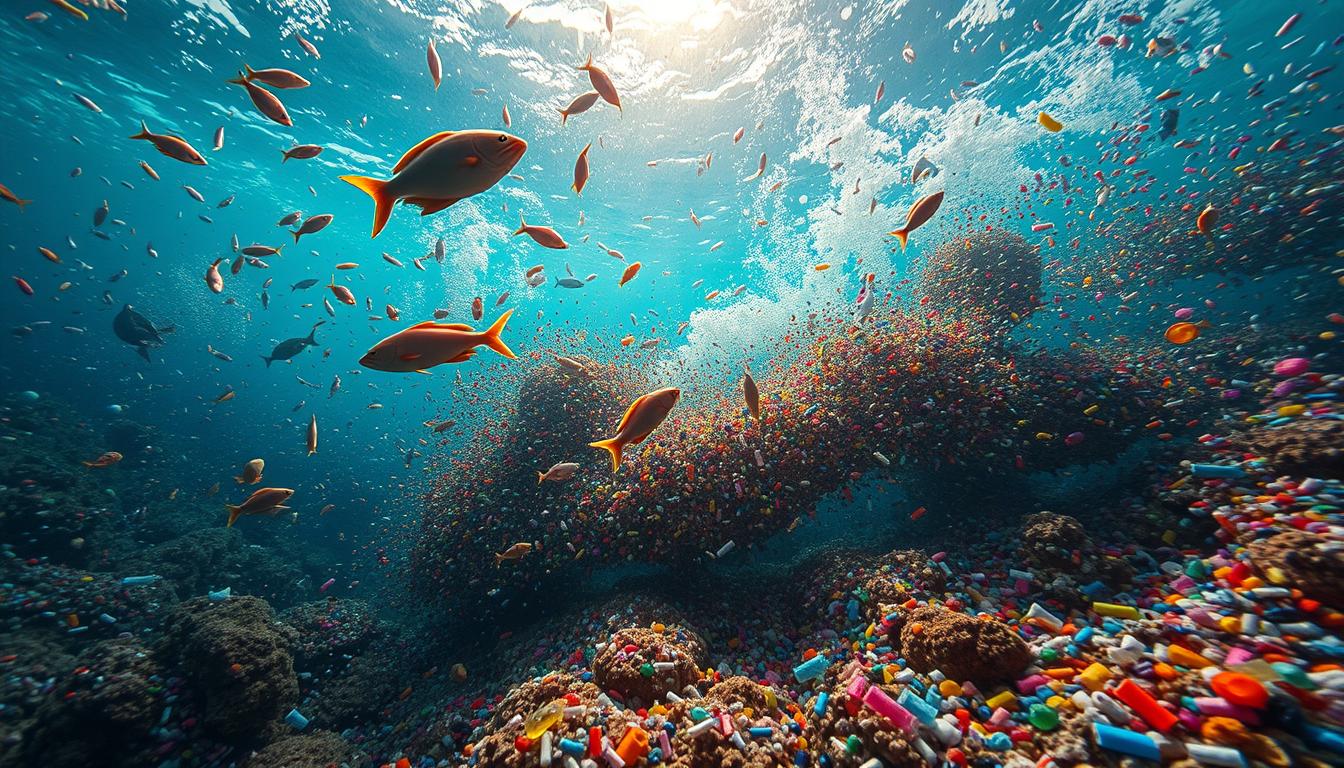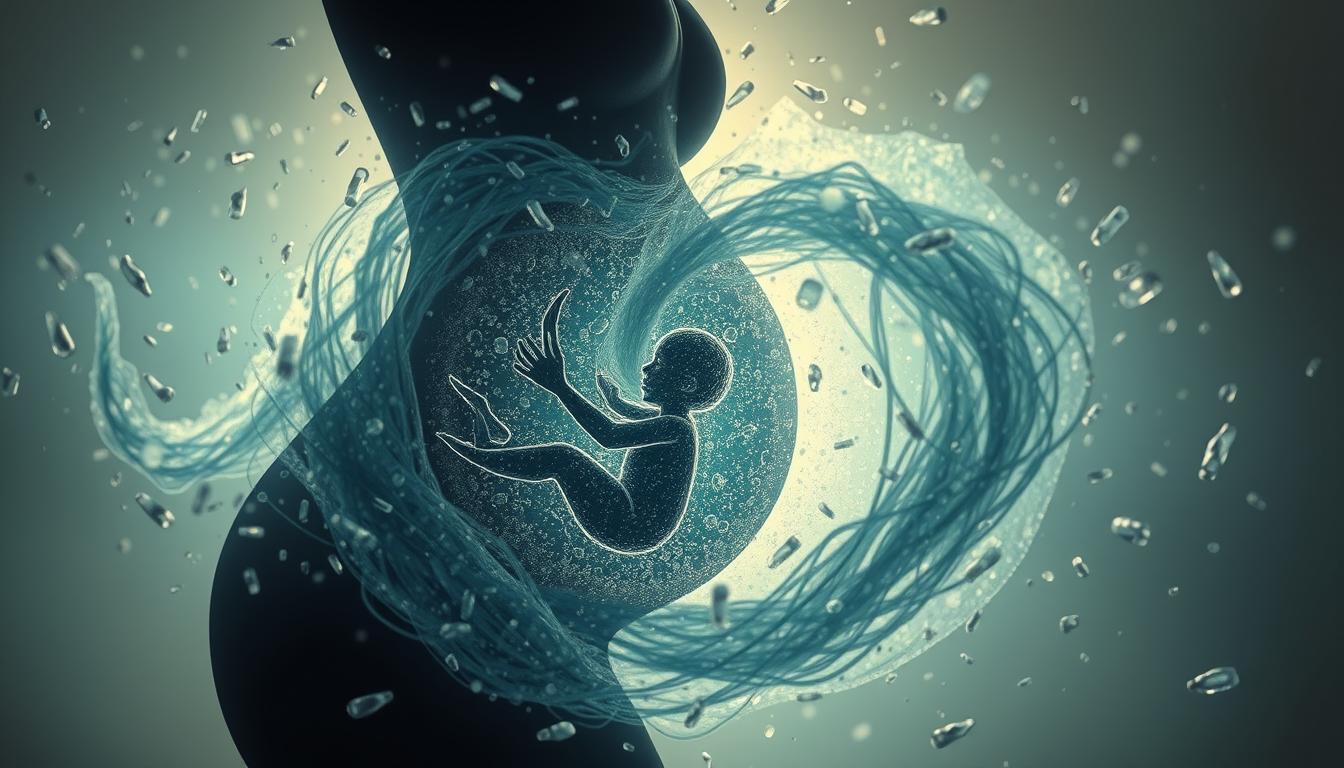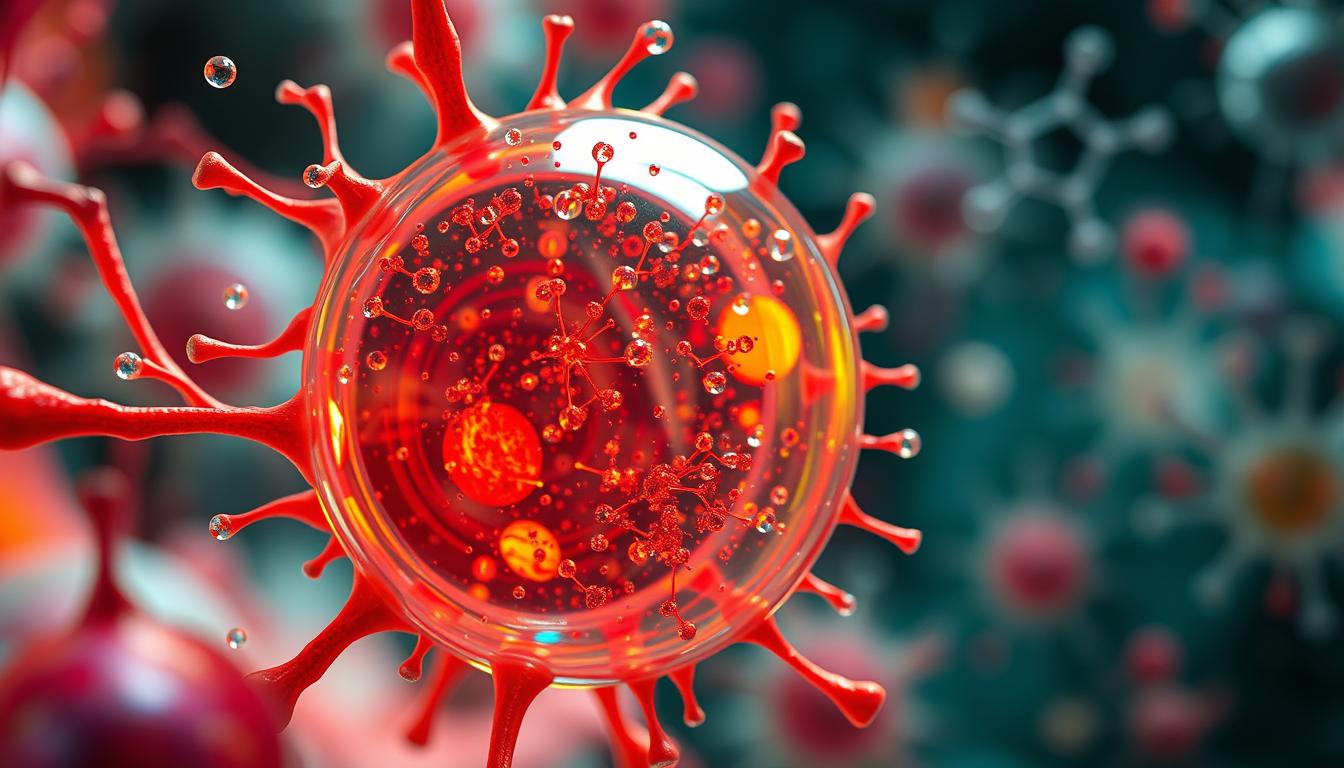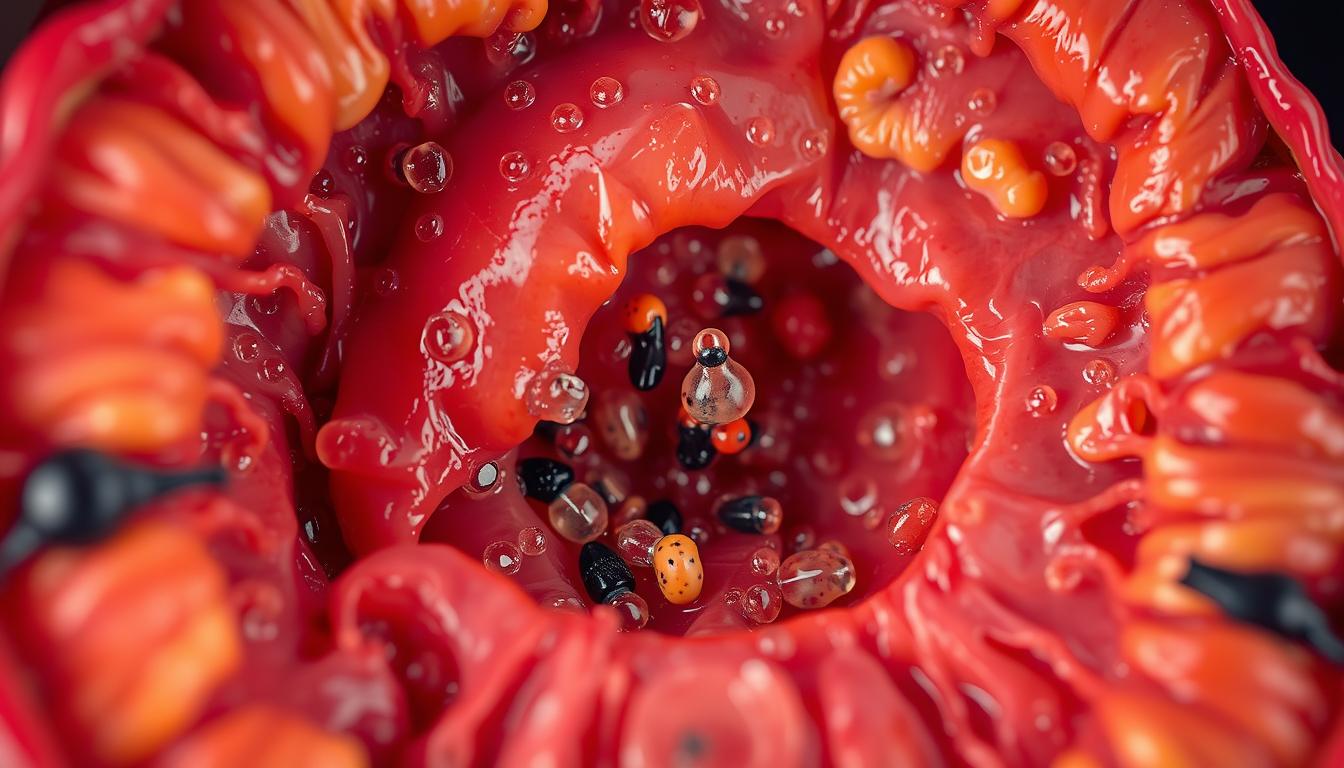Microplastic pollution is a big worry because it’s everywhere and can harm us. It leads to oxidative stress and exposure to harmful toxins1. You can find out more about it and its health effects with the Bye Microplastics AI app. It’s available on App Store and Google Play.
Studies show that microplastics are tiny plastic pieces, 0.1 to 5000 µm in size. The smallest ones, 1 µm to 10 µm, cause the most harm1. There are many studies on microplastics and oxidative stress, with 718 articles found1.
Microplastics pollute our environment and harm our health, causing oxidative stress2. From the 1950s to 2013, 299 million tons of plastics were made. At least 10% of these plastics end up in our oceans2.
Understanding Microplastics
Microplastics are tiny plastic pieces that harm cells and cause stress in marine life. They are a big problem in oceans where pollution is high3. Knowing what microplastics are and where they come from is key to solving this pollution issue.
Microplastics can be found in both water and on land. Studies show they can change the levels of antioxidant enzymes in some living things. This suggests they might cause oxidative stress4.
Definition and Composition
Microplastics are plastic bits under 5 millimeters. They can be either primary or secondary. Primary ones are made small, while secondary ones break down from bigger plastics.
Sources of Microplastics
Microplastics come from many places. They include microbeads in face wash, fibers from clothes, and broken-down plastic. They get into the environment through wastewater and land runoff.
Common Types Found in the Environment
Common microplastics are polyethylene, polypropylene, and PVC. These can harm sea creatures, from tiny invertebrates to big fish3.
Knowing about microplastic types and sources helps us fight ocean pollution. It also helps lessen the harm they cause to cells4.
The Science of Oxidative Stress
Oxidative stress happens when there’s too much damage from free radicals and not enough antioxidants. This imbalance can harm cells and cause inflammation. Microplastics can lead to oxidative stress, which is bad for our health5. It’s important to understand this to find ways to fight microplastic harm.
Microplastics can upset the balance in our environment, causing oxidative stress. This leads to the creation of harmful free radicals6. These free radicals can damage cells and cause inflammation. For instance, studies found that microplastics can make adult daphnids produce 61% more free radicals6.
Many organisms, like marine copepods6, are affected by microplastic-induced oxidative stress. The third web source talks about how microplastics harm the marine copepod Paracyclopina nana. It shows how oxidative stress plays a big role in this harm. To tackle microplastic problems, we need to know how they interact with cells and cause stress.
Other things, like pollutants like mercury, can also cause oxidative stress7. Mercury can build up in organisms and lead to stress. It’s key to understand how microplastics, oxidative stress, and pollutants interact. This knowledge helps us find ways to protect our health and the environment from microplastic harm.
Mechanism of Microplastic-Induced Oxidative Stress
When microplastics meet cells, they cause the cells to produce harmful reactive oxygen species (ROS). This leads to cell damage8. This damage can disrupt how cells work and cause health issues. Microplastics also release toxins into the environment, making things worse9.
ROS plays a big role in this damage. It can harm DNA, proteins, and lipids in cells8. The more microplastics there are, the more ROS is made. This increases oxidative stress and cell damage9. Knowing how microplastics cause oxidative stress helps us find ways to lessen its effects and protect against environmental toxins.
- Microplastics can range in size from 1 μm to 5 mm8.
- Exposure to microplastics may occur through ingestion, inhalation, and dermal contact, contributing to organ toxicity and neurotoxicity9.
- The presence of microplastics can lead to increased oxidative stress and cell damage89.
Effects on Human Health
Microplastic pollution is a big risk for people, like kids, pregnant women, and those with health issues10. It can cause inflammation, cell damage, and more. We need studies to know how it affects us and find ways to stop it11.
Research shows microplastics can cause allergic reactions and even cell death in humans10. They’re found in seafood, salt, and processed foods, making us eat them by accident10. The European Food Safety Authority (EFSA) says we don’t know enough about their impact on our health10.
Potential Risks of Oxidative Stress
The harm microplastics can do to our health is a big worry. They can break down into tiny pieces when heated in water, releasing millions of particles10. This shows we need more research on how they affect us and the planet.
Vulnerable Populations at Risk
Some groups, like kids and pregnant women, are more at risk from microplastics11. Their bodies are growing and their immune systems are weak. We must learn more about the dangers and find ways to protect them and our planet.
Environmental Impacts of Microplastics
Microplastics harm the environment, mainly in water, causing marine pollution and hurting ocean health. They can be eaten by sea creatures, leading to harm and toxicity12.
Studies show that microplastics change how sea life behaves, grows, and lives together13. For instance, a study on Paracyclopina nana found that microplastics messed up its home, showing we must fight marine pollution and lessen the plastic waste impact on ocean health.
To grasp the harm of microplastics, we must look at a few key points:
- Sea creatures eating microplastics
- Physical harm and toxicity from microplastics
- Changes in sea life’s behavior, growth, and living together
The lasting effects of microplastic pollution on ecosystems are being studied. But it’s clear we must tackle marine pollution and cut the plastic waste impact on ocean health to keep ecosystems healthy and sustainable12.
The Role of Antioxidants
Antioxidants are key in fighting oxidative stress. They neutralize harmful oxygen species and protect cells. Eating foods high in antioxidants like vitamins C and E can help14. Knowing how antioxidants work is vital for fighting microplastic harm to our health.
Antioxidants come in two forms: natural and synthetic. Natural ones, like polyphenols, are in foods like fruits, veggies, and nuts15. Synthetic ones are made and used in supplements. Both can help lessen microplastic stress on our bodies.
Some natural antioxidants include:
- Vitamins C and E
- Polyphenols
- Flavonoids
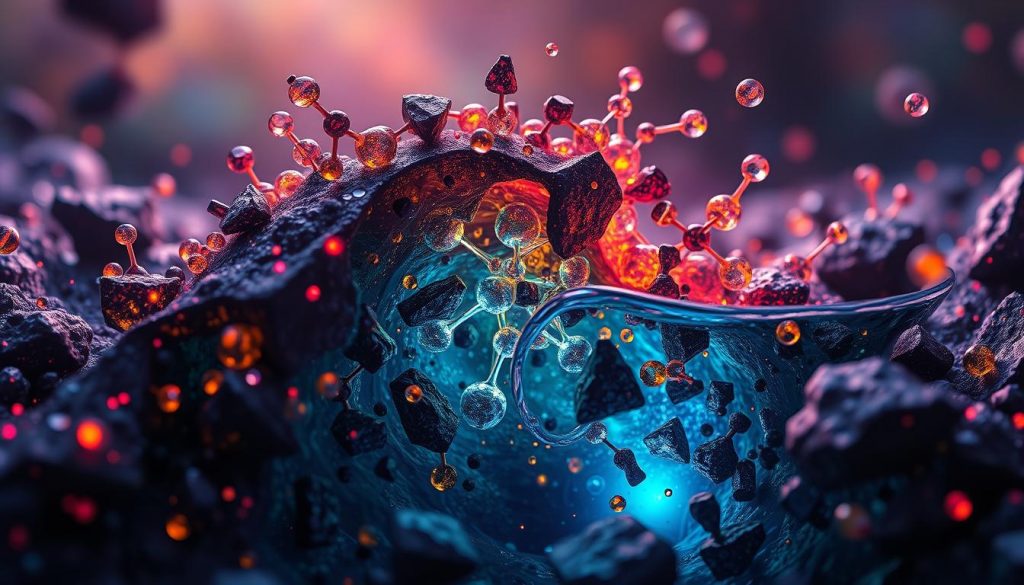
Remember, antioxidants help but don’t replace avoiding microplastics. Eating antioxidant-rich foods and reducing microplastic exposure protects us15.
Current Research on Microplastics
Scientists are constantly studying microplastics, focusing on their effects on humans and the environment16. Microplastics are tiny pieces of plastic, smaller than 5 mm, and don’t break down easily17. They harm aquatic life, like fish and birds, and researchers are worried about their impact on us too16.
Recent studies found microplastics in human tissues, like the placenta and lungs16. Being around microplastics for a long time can cause cell damage, which is bad for our health16.
Exposure to microplastics also makes our bodies produce more antioxidants, like SOD and CAT16. These antioxidants are signs of stress in our cells. This research shows we need to learn more about how microplastics affect us and the planet. We also need to find ways to reduce their presence.
| Year | Country | Regulation |
|---|---|---|
| 2014 | United States | Ban on microbeads in personal care products |
| 2015 | California, New Jersey, New York | Bans on microbeads in cosmetic products |
| 2016 | Canada | Ban on microbeads for exfoliation and cleansing products |
Regulatory Frameworks
When thinking about microplastic pollution, it’s key to know the rules in place. Laws like the Microbead-Free Waters Act aim to cut down microplastics in our environment18. But, enforcing these laws is tough due to funding and resource issues.
New ideas, like making companies responsible for their waste, could help19. The aim is to lessen microplastic pollution and its harm to humans and the planet. Experts say rules are vital to tackle this pollution’s effects.
The table below highlights important facts about microplastic pollution and its regulation:
| Category | Description |
|---|---|
| Microplastic pollution | Pollution caused by small plastic particles in the environment |
| Human health risk | Risk of harm to human health due to microplastic pollution |
| Toxicity effects | Harmful effects of microplastics on living organisms |
Knowing about the rules and new ideas helps us deal with microplastic pollution. It’s important for our health and the planet’s well-being18.
Public Awareness and Education
It’s important to raise awareness about microplastic pollution. This can help people understand its impact on health and the environment. A study found that most people know about microplastics in water, but not as much about other environmental contamination20.
Using social media and community programs can help teach people about plastic pollution. For example, studies show that 83% of tap water samples contain microplastics. Also, 94% of bottled water samples have microplastics21. Sharing this info can motivate people to act against microplastic pollution.
Some important facts about microplastic pollution include:
- Microplastics are found in about 20% of the animal protein eaten by nearly 3 billion people worldwide20.
- They are also found in foods like honey, sugar, beer, and sea salt20.
- Microplastics can carry harmful pollutants, making them more dangerous in marine ecosystems21.

By teaching the public about the dangers of microplastic pollution, we can all work together. This will help reduce its harmful effects on health and the environment.
| Source | Findings |
|---|---|
| Link 1 | Microplastics are present in approximately 20% of the animal protein intake for nearly 3 billion people worldwide |
| Link 2 | Microplastics have been found in 83% of tap water samples tested across various studies |
Mitigation Strategies
To lessen the harm of microplastic pollution, we must act. Reducing plastic use and recycling more are key steps22. New recycling tech can also help cut down microplastics in nature1.
Everyone can help by making smart choices. Avoiding products with microbeads and choosing items with less packaging are good starts22. Joining beach cleanups and supporting groups fighting pollution are also important1.
Some main ways to fight microplastic pollution include:
- Reducing plastic use and increasing recycling
- Implementing extended producer responsibility for plastic products
- Improving waste management infrastructure, specially in developing countries
- Promoting education and awareness about the impacts of microplastic pollution
By joining forces, we can lower the risks to human health from microplastics1. It’s vital to tackle this problem to safeguard our environment and health.
| Strategy | Description |
|---|---|
| Reduce plastic use | Decrease the amount of plastic used in daily life |
| Improve waste management | Implement effective waste management systems to prevent microplastic pollution |
| Education and awareness | Promote education and awareness about the impacts of microplastic pollution |
Global Efforts to Combat Microplastics
Microplastic pollution is a big problem for our environment and health. It causes cell damage and introduces toxins into our ecosystems. Countries worldwide are joining forces to tackle this issue.
The United Nations Environment Programme is leading the charge. They aim to cut down microplastic pollution through global cooperation and sharing knowledge23. Research on microplastics’ impact on health and the environment is also underway24.
To tackle microplastic pollution, we need to know where it comes from and how it affects us. Here are some key facts:
| Source | Amount of Microplastics |
|---|---|
| Plastic production | Over 350 million tons annually23 |
| Microplastics in oceans | Approximately 269 million tons25 |
| Microplastic pollution in the Mediterranean Sea | Thousands of particles per cubic meter25 |
By working together and sharing our knowledge, we can find ways to reduce microplastic pollution. This will help protect our environment and health24.
Conclusion: The Path Forward
The impact of microplastic pollution on human health and the environment is urgent26. Microplastics in our ecosystems, like oceans and air, harm marine life and human health2627.
We need everyone, including governments, businesses, and individuals, to act26. We must find ways to reduce microplastic pollution. This means using new waste management methods and teaching people to live more sustainably.
You can help make a big difference. Start by using less plastic, throwing away waste correctly, and backing policies against microplastic pollution2627. Together, we can fight this global problem and create a better future for our planet and all living things2627.
FAQ
What are microplastics and how do they contribute to oxidative stress?
What are the sources and types of microplastics?
How does oxidative stress affect organisms?
What are the mechanisms of microplastic-induced oxidative stress?
How do microplastics affect human health?
What are the environmental impacts of microplastics?
How can antioxidants help combat microplastic-induced oxidative stress?
What is the current state of research on microplastics?
What are the regulatory frameworks for addressing microplastic pollution?
How can the public be engaged in addressing microplastic pollution?
What are the mitigation strategies for addressing microplastic pollution?
What are the global efforts to combat microplastics?
Source Links
- Microplastics and Oxidative Stress—Current Problems and Prospects
- Adverse effects of microplastics and oxidative stress-induced MAPK/Nrf2 pathway-mediated defense mechanisms in the marine copepod Paracyclopina nana – Scientific Reports
- Short- and long-term polystyrene nano- and microplastic exposure promotes oxidative stress and divergently affects skin cell architecture and Wnt/beta-catenin signaling – Particle and Fibre Toxicology
- Microplastics exposure causes oxidative stress and microbiota dysbiosis in planarian Dugesia japonica – PubMed
- Microplastic-Induced Oxidative Stress in Metolachlor-Degrading Filamentous Fungus Trichoderma harzianum – PubMed
- Ecotoxicology of Polystyrene Microplastic Fragments: Oxidative Stress Effects in Neonate Versus Adult Daphnia magna – Water, Air, & Soil Pollution
- Microplastics increase mercury bioconcentration in gills and bioaccumulation in the liver, and cause oxidative stress and damage in Dicentrarchus labrax juveniles – Scientific Reports
- Microplastic-Induced Oxidative Stress in Metolachlor-Degrading Filamentous Fungus Trichoderma harzianum
- Polystyrene Microplastics Induce Oxidative Stress in Mouse Hepatocytes in Relation to Their Size
- Impacts of micro and nanoplastics on human health – Bulletin of the National Research Centre
- Frontiers | Effects of Microplastics on Fish and in Human Health
- Polyethylene microplastics affect behavioural, oxidative stress, and molecular responses in the Drosophila model
- Microplastics Exposure Causes Negligible Effects on the Oxidative Response Enzymes Glutathione Reductase and Peroxidase in the Oligochaete Tubifex tubifex
- Impact of polyethylene microplastics exposure on kallikrein-3 levels, steroidal-thyroidal hormones, and antioxidant status in murine model: protective potentials of naringin – Scientific Reports
- Frontiers | Effects of microplastics, pesticides and nano-materials on fish health, oxidative stress and antioxidant defense mechanism
- Molecular and Cellular Effects of Microplastics and Nanoplastics: Focus on Inflammation and Senescence
- Health Effects of Microplastic Exposures: Current Issues and Perspectives in South Korea
- The Burden of Microplastics Pollution and Contending Policies and Regulations
- Micro- and nano-plastics activation of oxidative and inflammatory adverse outcome pathways
- Microplastic in Food and Water: Current Knowledge and Awareness of Consumers
- Microplastics as an Emerging Threat to the Global Environment and Human Health
- Mitigating Dietary Microplastic Accumulation and Oxidative Stress Response in European Seabass (Dicentrarchus labrax) Juveniles Using a Natural Microencapsulated Antioxidant
- Microplastics, a Global Issue: Human Exposure through Environmental and Dietary Sources
- Research recommendations to better understand the potential health impacts of microplastics to humans and aquatic ecosystems – Microplastics and Nanoplastics
- Microplastic sources, formation, toxicity and remediation: a review – Environmental Chemistry Letters
- Microplastic menace: a path forward with innovative solutions to reduce pollution – Asian Journal of Atmospheric Environment
- Effects of microplastics, pesticides and nano-materials on fish health, oxidative stress and antioxidant defense mechanism
